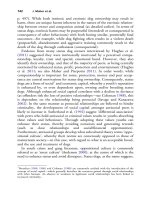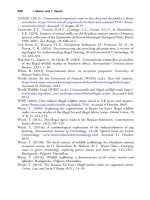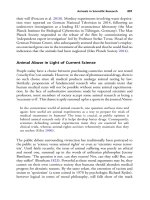The palgrave international handbook of a 128
Bạn đang xem bản rút gọn của tài liệu. Xem và tải ngay bản đầy đủ của tài liệu tại đây (37.17 KB, 1 trang )
118
A. Arluke et al.
will change dramatically within days of removal. It should be argued that
the detailed medical and behavioral evidence recorded regarding the
initial conditions of the animals at the time of rescue can be reviewed
by defense experts and that the condition of animals held for more than
several weeks is of limited evidentiary value.
Alternatives to Prosecution
One therapeutic model that could serve as an alternative to prosecution is
relapse prevention, a cognitive-behavioral approach with the goal of identifying and preventing high-risk situations that has generally been applied to
substance abuse, obsessive-compulsive behavior and sexual offending
(Witkiewitz and Marlatt 2004). However, animal hoarding presents significant challenges to this approach. In an analysis of relapse episodes obtained
from clients with a variety of addictive behavior problems, three high-risk
situations were associated with most of the relapses reported (Marlatt and
Gordon 1985). They were negative emotional states, interpersonal conflict
and social pressure, as well as cognitive distortions such as denial and
rationalization. All of these obstacles are commonly encountered in dealing
with animal hoarders.
Another intervention model that can be an appropriate response to
animal hoarding cases is harm reduction, a range of policies designed to
reduce the harmful consequences associated with various human behaviors, both legal and illegal. This approach accepts the fact that it may
not be possible to stop the ‘risky’ behavior and instead attempts to
prevent harm through close monitoring and ‘wraparound’ support services. In the case of animal hoarding, this would include frequent
interaction with the client, spay/neuter assistance, veterinary care, environmental clean-up and connection to various social services, a model
already used by many humane agencies.
Many communities have recognized the importance of an interdisciplinary
approach to these situations and have established hoarding task forces that
also include animal welfare professionals. Cooperation of a broad spectrum
of municipal agencies and social service organizations can optimize the
resolution of hoarding cases. Desirable members of such a task force would
include representatives from animal control, public health and mental health
agencies, child welfare and adult protective services, zoning and fire prevention officials, and veterinarians (Patronek 2001). This can be a very important step to overcome potential conflicts of interest and concerns about









